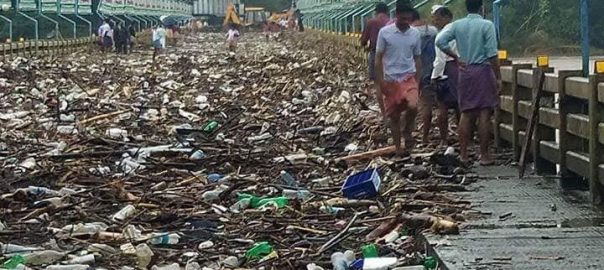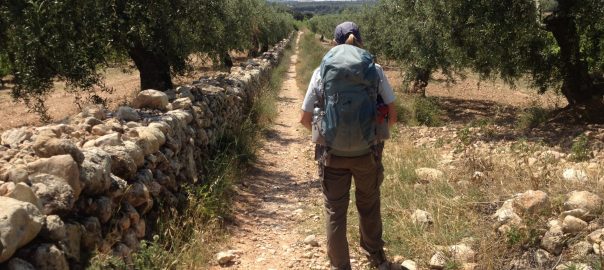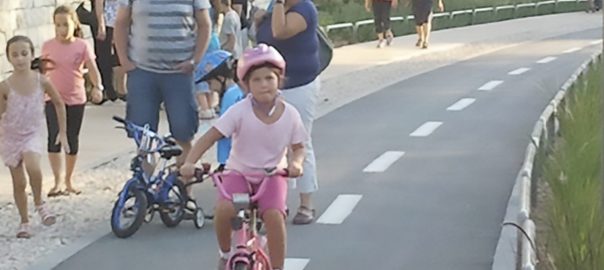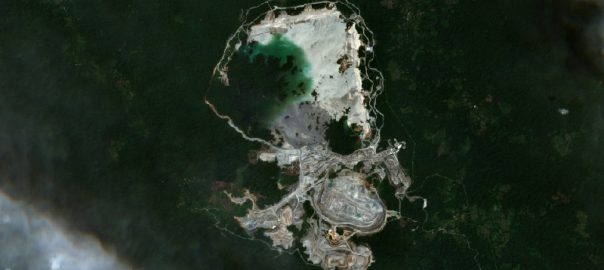Three lenses—ecocentrism, sustainability, and urban political ecology—offer different ways to look at the same problem. Viewed together they offer nuance. Separately they can mute aspects in the other two that “don’t fit”. This is especially true in southern cities.
One visual that circulated widely through social media was that of the Malayatoor Kodanad bridge. Receding floodwaters had left behind large amounts of plastic waste on the bridge. An earthmover was used by local residents to throw the waste back into the river. An image and associated video went viral on social media and was shared repeatedly. A well-known radio jockey tweeted, “see what these idiots are doing to clear the Malayattoor bridge. They are putting it back into the river!! Will we ever learn??” Another woman shared the picture and said “the Malayattur Kodanad bridge (Kerala) after flood waters receded. All the ‘gifts’ from mankind to the river have been returned with thanks”. Yet another concerned individual shared a video of the incident with the opinion that “after all that has happened in #Kerala, this is how we treat our rivers—dumping all the debris, including plastic bottles, that the Periyar left on the Malayattoor bridge back in the river”. Someone else said “Kerala’s river tossed plastic waste onto its streets and bridges only to have clearing teams toss it back in after the devastating floods cleared.” The media editor of the Indian Express, a prominent newspaper in the country shared the image with the caption: “Nature has its own way of giving it back. This is the Malayatur-Kodanad bridge after waters recede”. The picture also made its way into international media, with headlines such as “Plastic waste and debris is dumped BACK into the river in ‘clean up’ operation after devastating floods in Kerala that killed 410 people and have left more than a million in relief camps”.

A different perspective came through when Dhanya Rajendran, the editor in chief of an Indian e-magazine the Newsminute.in, conducted a local investigation. The story that then emerged was not one of callous disregard for nature, but rather one in which residents had to make a quick decision and act, in very difficult circumstances. The article quoted residents saying, “For two days, we could not go anywhere near the bridge. The currents were so strong and it was neck-deep water on either side of the bridge… On Friday, August 17, as the water receded a bit, someone from the Malayattoor brought an earthmover.” The flood had affected all the surrounding areas, further disrupting connectivity. The article further quoted local police officers. “There was water on either side of the bridge and there was no time to take the garbage elsewhere…Where could we have taken the earthmover to dump the garbage? There was no place. There was water everywhere…The situation was critical, relief and rescue was getting obstructed, so they put it back into the river”.
The piled up wastes created a potential health hazard which had to be treated. According to the secretary of the village panchayat (village council), “It was the need of the hour. The garbage had blocked the bridge, we were also scared that with the garbage blocking the flow of the water, it may get diverted into the village, in case the water levels rose again”. The circulating visuals also caused a certain amount of distress among the people. A District Committee member who spoke for the people had this to say, “People are upset. We have been portrayed as people who dump into the river unscrupulously. They don’t even want to clear garbage and carcasses accumulated everywhere. They are worried if cases will be filed against them too… How is our village alone responsible for all the garbage? Right from Idukki (another city upstream of the location), locals and tourists have been chucking garbage recklessly into this river for decades. This had to happen”.
This incident brought to light the consequences of framing details used to judge a distant event without adequate context. The image circulated in this case was used by people to create a narrative that both romanticized nature and lamented the destructive influence of human beings on it—the lens of ecocentrism. Seen this way, the incident became a snapshot of a community that supposedly generated the waste, and who were punished by having it thrown back into their midst by the flood. The community was further perceived as one that did not care about what happened to nature because their response of throwing that plastic back into the waters made them appear callous and uncaring. Strengthening this perception were its links to an already burning issue in mainstream media—marine plastics that have similarly washed up on urban beaches across the world, and which have generated equally powerful visuals such as those of animals choking on them.
One could also frame this issue through the lens of sustainability. In an online course we conduct at Azim Premji University, we discuss sustainability and its challenges as being framed by the complex interplay of the 3F’s: finitude (limits), fragility, and fairness. Put this way, the floods reflected the fragile state of the social ecological system, both in its physical manifestation, as well as in the plastic it deposited on the beach. It was this fragility that was represented in the various social media mentions of the event. Also represented were narratives of the pollution of a finite, yet important resource: water. What was missing however, was the related idea of fairness. Was it fair to blame the villagers for taking one of the few options available to them in a disconnected landscape? Was it fair to blame only the people at the physical location where the plastic washed up? Water flows down a slope and was it not likely that the plastics washed up on the bridge was partly generated by communities living upstream of the bridge? It was also not fair that people in other parts of the country and who were disconnected from the experience of the flood blamed the flood affected communities within the dry comfort of their homes and offices.
Another perspective that can be used to understand this story is that of urban political ecology. It seems unlikely that the plastic washed up on the bridge could have been generated only by the locals, particularly given that the state of Kerala (and particularly the landscape upstream of the bridge) is a well-known tourist destination. It is also unlikely the plastic was generated only at one source (by the community affected), instead probably being carried by the water at several locations (occupied by people of different social, economic, and political statuses) along the course of the river before coming up against the bridge. It is also unrealistic to assume that all communities had equal access and ability to discard the trash that eventually washed up on that bridge. Overall, the problem of plastic wastes is one which was already present in the landscape but which was made more visible by the flood.
By examining the event through this lens, and contrasting it with the narratives built around the issue through social media, one can also see how social media narratives contributed to marginalizing an already vulnerable group of people. First, it created a dichotomous segregation of people—those who did not care about the environment (flood affected near the bridge) and those who did. The people who fell in the latter category were those who by virtue of not being disconnected by the floods, were also considerably more privileged in that they had better access to resources and the ability to share the visual multiple times. Secondly, by creating that dichotomy, it also assigned complete blame on people who may have had only a partial role in the creation of the disaster. In doing so, the narrative muted several aspects of the complex nature of this issue: such as upstream-downstream dynamics and external sources of pollution. Instead, it drew attention to only one partial aspect of the entire story—that of people throwing the waste back into the waters, which of course, goes against all notions of sustainable lifestyles.
These three lenses—ecocentrism, sustainability, and urban political ecology—offer different ways to look at the same problem. While ecocentrism adopts a primarily ecological viewpoint that posits all human influence as being equally disruptive to the delicate balance of nature, sustainability recognizes that there is an inherent issue of fairness in these debates: who is affected, why are they affected, and how differently they are affected. Both these perspectives however offer only a static, temporally independent snapshot of events and challenges, that are often more complex and dynamic in nature. Missing in these perspectives issues however, are a few key things: the historical trajectories of how these cities got to where they are currently, the colonial and postcolonial regimes that shaped urban socio-natures in these global south cities. Third, the differential experiences of urban populations (separated as they are by economic, social, and gendered divides) with respect to events leading up to the disaster, the disaster itself, and the responses that followed. Also the differences in political bargaining power of these various sections of the society that feed back into their experiences of such social-ecological disasters.
Urban political ecology with its explicitly historical-geographical approach that also internalizes nature in cities offers the right set of tools to bring out these nuances and complexities clearly. The discipline also recognizes the subjectivities induced by inherently power laden dynamics of urban social-ecological interactions, thus allowing one to critically examine processes of inclusion, exploitation, domination, repression, and subjugation in the creation of the urban terrain. Yet, as complex as this picture is, urban political ecology may provide only a partial picture of the social-ecological complexities that are characteristic of cities within the global south such as those within India.
A senior academic at a recent workshop HU was part of said “It is very annoying, sometimes I feel like scientists who study the subjectivities of social-ecological systems have two boxes – one a highly detailed, heterogeneous ‘people’ box and a much less complex ‘ecology’ box. While a lot of effort goes into the detailing of the ‘people’ box, much less effort is made to understand the ecological processes and feedbacks that interact with the subjectivities of society.” This quip made in jest, sums up one of the most evident critiques of urban political ecology—where is the ecology? The urban is a process of social-ecological change, and all too often, the ecological nuances of urbanization get subsumed or trivialized because of the political critique of societal interactions with nature.
Second, while urban political ecology does look at continuities and interactions between rural and urban spaces, there still remains a certain dichotomy in characterizing these continuums. In southern cities, which have grown by engulfing peri-urban villages, such dichotomies remain insufficient in explaining dynamics of interactions within a place where sprawling paddy fields and grazing livestock may be found a mere stone’s throw away from corporate giants and gated communities, thus creating a unique set of challenges towards understanding the landscape. Urban political ecology further takes a critical approach towards understanding the uneven expressions of power that shape nature-society relationships and the production of urban nature across multiple scales—local, regional, and global. Yet, in many cities of the global south, one may encounter heterogeneous interactions with multiple expressions of power at the same scale. These interact both with each other as well as across multiple scales to shape inclusions and exclusions of societal groups within emerging nature-society interactions and eventually the urban terrain itself. Such interactions remain sparsely captured in scholarly literature and deserve greater attention.
For example, these heterogeneous expressions of power were very noticeable in the case of plastics washing up on that bridge in Kerala. While the state boasts of high levels of communal harmony (particularly noticeable during adverse situations like floods), day to day interactions however remain differentiated heavily along communal, caste, and religious divides, each of which create different experiences of domination and repression within the communities. Yet, all of them, irrespective of their individual social identity became uniformly marginalized through the imagery circulated by equally heterogeneous communities about their perceived lack of respect to the water body. Such nuances, identity fluxes and heterogeneities are often not captured in an urban political ecological knowledge that is situated within knowledges derived from studying relatively less heterogeneous contexts of the global north.
In relation to the event presented here, each of the three perspectives we have discussed offer different ways to understand complex social ecological interactions. Taken separately, each of them offer particular and situated ways of looking at the issue, while muting and subsuming aspects of the issue that do not fall within that particular frame. Taken together, however, they begin to partially capture the social and ecological interactions that frame a particular issue—yet with particular shortcomings when applied in contexts of the global south. It is these subtle nuances that need to be captured effectively when studying cities and their complex nature-society interactions. What is also needed is better dissemination of these critical nuances into the public realm, not driven by popular, mainstream ideas of what environmentalism means, but in ways that capture the hows and whys of a given situation.
For if there was anything that photograph of flooded Kerala showed us, it was that we need more nuanced, integrated, and open hearted analysis, even within the realms of science.
Hita Unnikrishnan and Harini Nagendra
Bangalore
about the writer
Harini Nagendra
Harini Nagendra is a Professor of Sustainability at Azim Premji University, Bangalore, India. She uses social and ecological approaches to examine the factors shaping the sustainability of forests and cities in the south Asian context. Her books include “Cities and Canopies: Trees of Indian Cities” and “Shades of Blue: Connecting the Drops in India’s Cities” (Penguin India, 2023) (with Seema Mundoli), and “The Bangalore Detectives Club” historical mystery series set in 1920s colonial India.







Leave a Reply